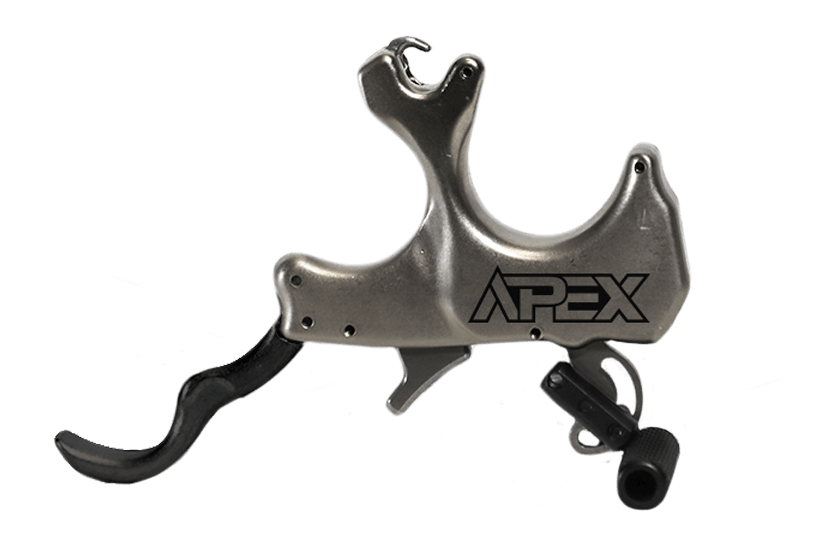
Nearly all the best target archers and bowhunters use a handheld, thumb-triggered release aid. This series of columns will take a closer look at the reasons why and help you determine whether a thumb release could help your own shooting.
The vast majority of bowhunters who shoot compound bows use a release aid to “loose the arrow.” And the vast majority of those use a wrist-strap, index-finger release.
Most archers shot firearms long before they picked up a bow, and using the index finger to pull the trigger just seems natural to them. So, most beginning archers use this style of release aid, and that’s fine. However, the mistake they make is never trying any other style of release aid — one that just might improve their shooting.
Don’t get me wrong; there are many advantages to using and index-finger release. However, nearly all the very best hunting shots I know use a handheld, thumb-trigger release aid to hunt. There is definitely a “method to their madness,” and I want to discuss with you the reasons you might want to try one of these release aids to improve your hunting accuracy.
To start, I would like to tell you a short story that emphasizes this point (and also allows me to boast a bit). The Vegas Shoot is the largest and, arguably the most prestigious, archery tournament in the world. Nearly 4,000 top shooters come from all around the globe each year to test their skills against the finest shooters in the world. The first few years I competed there, I shot in the Bowhunter Class. At that time, shooters in this class were not allowed to use a scope or a long stabilizer. They were also not allowed to move their sight during competition.
Needless to say, the Bowhunter Class was at a distinct disadvantage to the open classes, especially the Unlimited Open Pro Class. Typically, bowhunters had scores much lower than the other classes.
I had competed at the Vegas tournament a few times before, and had used a wrist strap, index-finger style release aid with fairly decent results. Back then, I was very hungry for knowledge and extremely eager to learn! Studying the most elite archers there, I noticed very quickly that almost every archer shooting in the Unlimited Professional Class used a handheld release aid. Index-finger releases were seldom seen on that prestigious line.
So, I decided to up my game. The following year, at that same tournament, I came to the line with a handheld release aid firmly within my grasp. That particular tournament was a breakthrough event for me. At the end of the second day of competition, I was the only archer in the entire tournament with a perfect score, and I was shooting in the Bowhunter Class! No one else, including all the professionals, had shot perfectly.
The reason I am sharing this story with you is that the handheld release aid was the one and only thing I changed from the previous year’s shoot. It had made a huge difference in my accuracy and consistency. I am grateful to say that over the next 10 years, I went on to win quite a few world championships (in the Professional Class) while using a handheld release.
In this series of columns, I’ll explain the advantages and disadvantages of handheld, thumb-triggered release aids and why they might be just the ticket to improve your hunting accuracy. (Just for absolute clarity, I am NOT talking here about handheld hinge or back-tension release aids. I’ve covered them thoroughly in previous columns.) Then, I’ll get into the basics, as well as the fine intricacies, of shooting this style of release aid well. I’ll also give you some recommendations as to which styles might work best for hunting. Finally, I’ll give you some hacks to help solve any issues and overcome any disadvantages of using these release aids for hunting.
As a starter, let’s take a look at the key advantages and disadvantages of a handheld, thumb-triggered release compared to a wrist-strap, index-finger release. We’ll go over all of these considerations in the next few columns!

Advantages
- Increased accuracy
- More consistent anchor point
- Rotates release hand for improved back tension
- Reduces likelihood of “chin drag”
- Reduces likelihood of jerking the trigger
- May increase draw length
- Allows release hand to be free of encumbrances until ready to shoot
- Less likely to bang the release aid into something, spooking game in the process
- More refined, crisper and easily adjusted trigger
- May help with target panic
Disadvantages
- Less instinctive/intuitive to use
- Release is not always readily at hand/have to move to get it when needed
- More difficult to “snap shoot”
- Easier to lose in the field or drop from treestand
- Can slip out of your hand at full draw
- Can make your release hand very cold in freezing weather
- Metal housing can cause glare in the field, potentially allowing game to see you
- A wrist strap helps you draw more weight
- You must cock the release aid before shooting
- You must adjust your shooting form when switching from a wrist-strap release to a handheld release













